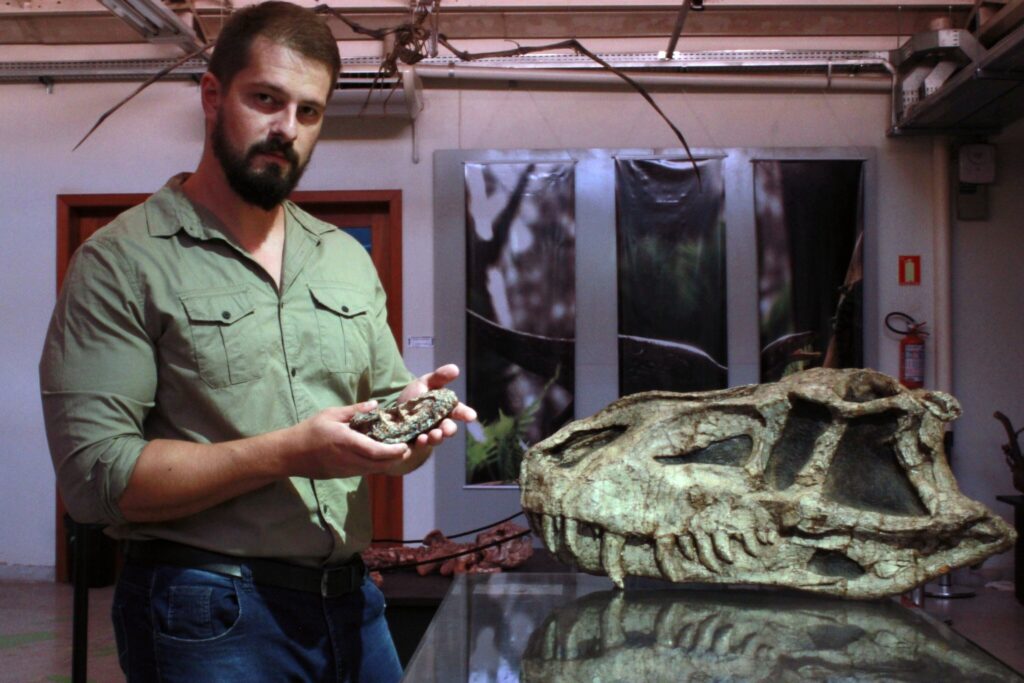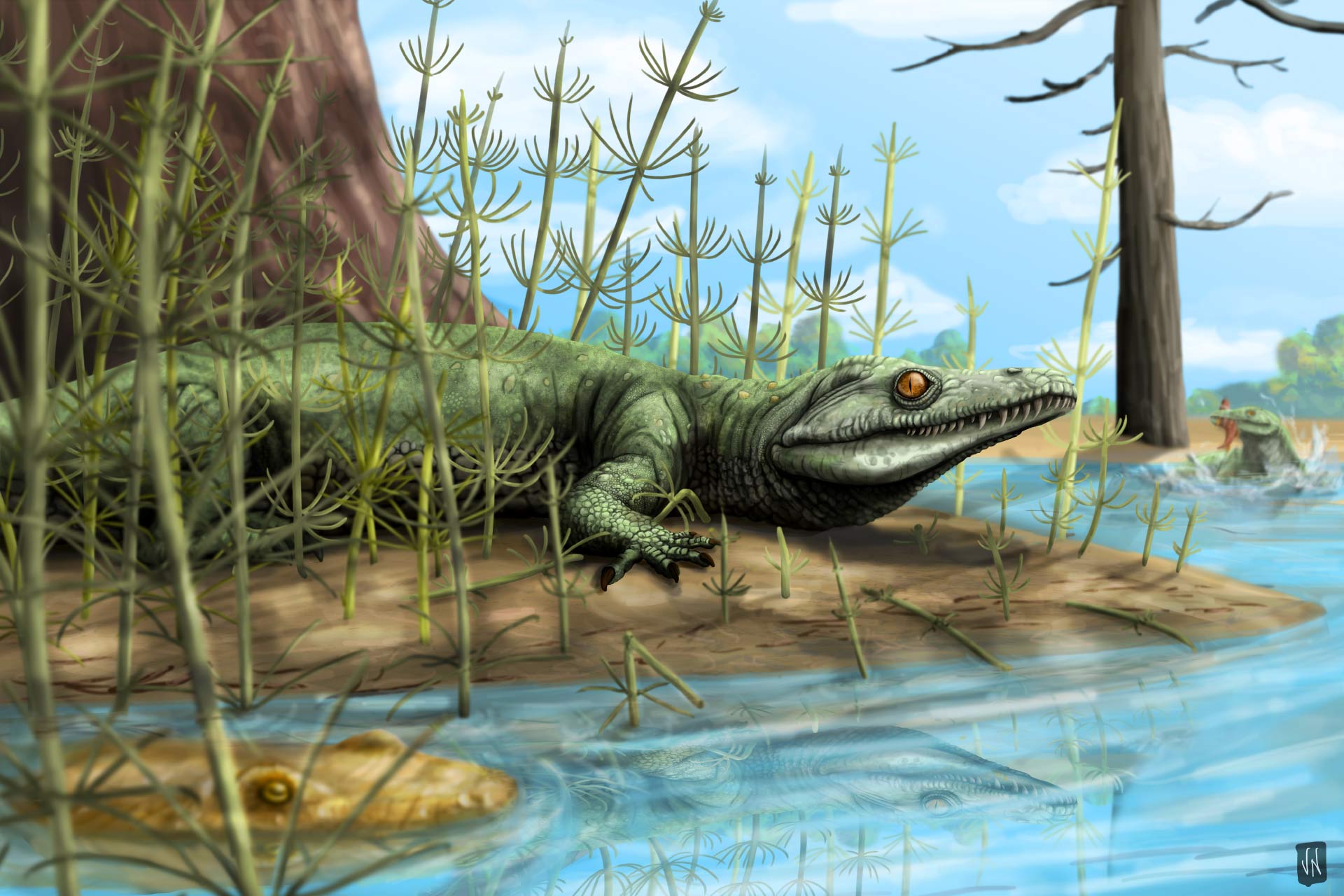In a new publication in Scientific Reports, scientists reported the discovery of a new species of ancient predatory reptile from the group of pseudosuchians: Parvosuchus aurelioi. This work made important contributions to understanding the diversity of early reptiles around 237 million years ago during the Middle-Late Triassic period in Earth’s history—the time before the rule of the dinosaurs.

Parvosuchus aurelioi is a crocodile-like reptile, rapidly resembling the species of today’s world, discovered in the formations of Santa Maria in Brazil. The fossil specimen was more comprehensively examined by Rodrigo Müller, which involves a partial skeleton with a complete skull, lower jaw, 11 dorsal vertebrae, pelvis, and partially preserved limbs. That is of interest in particular because it shows the first confirmation of a gracilisuchid species in Brazil, which gives a little light to the South American part of the evolutionary landscape of the small predatory reptiles during the Triassic.
The pseudosuchians were quite a heterogeneous group of four-legged reptiles, very common during the Triassic Period. Ranging from smaller gracilisuchids to large apex predators, these creatures occupied many ecological niches before the emergence of the dinosaurs. The discovery of Parvosuchus aurelioi showcases how part of the smaller pseudosuchians could coexist and adapt along with bigger relative species to understand ancient ecosystems and the predator-prey dynamics of the epoch.
The morphology of Parvosuchus aurelioi provides a number of interesting data regarding predatory behavior and ecological role. Its skull is 14.4 centimeters long, where the skull has been elongated and slim with jaws armed by teeth leaning backward at their ends—an peculiar adaptation for catching and devouring prey. A large number of openings in the skull also there underline its anatomic specialization, suggesting adaptations concerning sensory perception and thermal regulation similar to those of modern reptiles.
Also Read: Artificial Intelligence Surpasses Students in Practical “Turing Test”
Parvosuchus aurelioi is named in honor of Pedro Lucas Porcella Aurélio, an amateur paleontologist responsible for the discovery of the majority of fossil materials in Brazil. Such an act not only spells out Aurélio’s contribution to the paleontological research being helped along by people like him but at the same time underlines the very inclusiveness of scientific discovery, wherein both amateurs and professionals are almost equally fundamental to uncovering Earth’s ancient past.
Considering the geographical context of the find from the Santa Maria Formation, Brazil, the discovery contributes to the worldwide presence of Triassic pseudosuchians known up until this moment in China and Argentina. Parvosuchus aurelioi contributes significantly to our current knowledge of biogeography, as well as the evolution of early reptiles, with findings of remains from this genus in South America; this marked the South American continent, in general, as a paleontological and biodiversity hotspot during the Triassic Period.
The fossil record of Parvosuchus aurelioi thus contributes to standing debates or studies on evolutionary relationships within the pseudosuchian group. Researchers compare it with other gracilisuchids and larger relatives of pseudosuchians to get an idea of its phylogenetic patterns and ancient evolutionary trends for reptiles. Investigations of this nature are very crucial in mapping out the evolutionary tree of pseudosuchians and their evolution leading up to the rise of the dinosaurs.
The Parvosuchus aurelioi research becomes a clear case of intradisciplinary practice within paleontological study—through anatomy, evolutionary concepts, and geology—to rebuild ancient ecosystems and understand behaviors that disappeared with species. Advanced imaging techniques coupled with digital modeling make it possible to visualize and visualize in minute detail the fossil specimens, thereby making possible the precise reconstructions of the anatomical structures and ecological roles of extinct organisms.
Therefore, in the future, more exploration and digging for fossils in Brazil and other parts of the world will most probably be conducted to discover more fossil remains and learn more about early reptile diversity and evolution. That will provide an opportunity to shed some light on new species, provide a more accurate perception of paleoecosystems, and link environmental changes with biological adaptation through time.
The discovery of Parvosuchus aurelioi has greatly enhanced paleontological research into the early evolution and diversification of reptiles during the Triassic. This newfound species underlines the necessity of global collaboration in scientific discovery and places Brazil at the forefront of countries considered essential contributors to knowledge about prehistoric life on Earth.
Further examination of the recovered skeletal remains of Parvosuchus aurelioi has also yielded interesting information on its locomotion and probably ecological niche. Showing light construction, the partial skeleton—with 11 dorsal vertebrae and limb elements that are well-preserved—gives support to agile locomotion. This already is a characteristic feature of gracilisuchids; thus, it must be that P. aurelioi had followed a predatory lifestyle, probably preying on smaller vertebrates or aquatic organisms in its habitat.
The findings of Parvosuchus aurelioi in Brazil serve to outline the role of the Santa Maria Formation as an outstanding paleontological reserve. Many examples of fossil remains have come from this geologic formation, providing an unusual window on biodiversity and the evolutionary history of South America during the Triassic Period. Research excavations are currently going on at the site, which will also give even more details regarding the fauna and flora of this part of the world that existed millions of years ago.
Besides its scientific value, the scientific community is eager on the discovery of P. aurelioi for its shedding light on conservation efforts to preserve paleontological sites and their fossil resources. These areas not only enrich our knowledge of the Earth’s past but also encourage new generations of scientists and people who are interested in discovering and protecting the natural heritage of our planet. By protecting those areas—like the Santa Maria Formation—which hold critical fossils, we can ensure that important knowledge about ancient life forms such as Parvosuchus aurelioi will continue to be discovered and researched for generations to come.
The case of Parvosuchus aurelioi epitomizes the fact that paleontological research is by necessity interdisciplinary, reaching for methods and techniques from anatomy through evolutionary biology and geology toward the reconstruction of ancient ecosystems and decoding behaviors of extinct species. Advanced imaging techniques paired with digital modeling make it possible for researchers to see and study the fossil specimens in unprecedented detail and thereby bring forward accurate reconstructions of their anatomical structure and ecological role of extinct organisms.
The discovery of Parvosuchus aurelioi further opens perspectives toward comparative studies with other gracilisuchids and pseudosuchians worldwide. Comparison of morphological, behavioral, and ecological similarities and differences among these entities from different parts of the world and across geologic time will allow researchers to delve deeper into investigating the evolutionary patterns and environmental controls on early reptile diversification.
Comparative paleontological study is one of the keys to reconstructing old ecosystems and to explaining how organisms have behaved in relation to changing environmental conditions throughout Earth’s history. The more fossils that are found and studied, the greater the missing evolutionary picture of pseudosuchians like Parvosuchus aurelioi can be fitted together to provide meaningful insight into the context of vertebrate evolution during the Triassic Period and beyond.
Source: SciTechDaily

